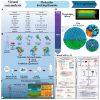Organic Fusion of Molecular Simulation and Wet-Lab Validation: A Promising High-Throughput Strategy for Screening Bioactive Food Peptides
- PMID: 40870802
- PMCID: PMC12385867
- DOI: 10.3390/foods14162890
Organic Fusion of Molecular Simulation and Wet-Lab Validation: A Promising High-Throughput Strategy for Screening Bioactive Food Peptides
Abstract
Peptides derived from protein sources in food exhibit a diverse array of biological activities. The screening, preparation, and functional investigation of bioactive peptides have become a focal area of research. This review summarizes the status of peptide activity mining, including the latest research progress in protein sources, peptide functions, and processing conditions. It critically evaluates the limitations of current bioactive peptide screening methods, including the drawbacks of traditional methods and molecular simulations. The potential of using molecular simulation for the virtual screening of potentially bioactive peptides is summarized. This includes virtual enzymatic digestion, molecular docking, simulation of non-thermal processing technologies, and the construction of organelle/cell models. The driving role of artificial intelligence in molecular simulation is also discussed. In addition, the structural information, mechanism, and structural analysis technique of action of the popular target proteins of foodborne bioactive peptides are summarized to provide a better reference for virtual-reality combinations.
Keywords: artificial intelligence; bioactive peptide; food protein; molecular simulation; non-thermal technology; receptor protein.
Conflict of interest statement
The authors declare no conflicts of interest.
Figures





Similar articles
-
[Research progress of peptide recognition-guided strategies for exosome isolation and enrichment].Se Pu. 2025 May;43(5):446-454. doi: 10.3724/SP.J.1123.2024.10015. Se Pu. 2025. PMID: 40331609 Free PMC article. Review. Chinese.
-
Bioactive peptides with potential anticancer properties from various food protein sources: status of recent research, production technologies, and developments.Crit Rev Biotechnol. 2025 Aug;45(5):1076-1097. doi: 10.1080/07388551.2024.2435965. Epub 2025 Jan 5. Crit Rev Biotechnol. 2025. PMID: 39757011 Review.
-
Prescription of Controlled Substances: Benefits and Risks.2025 Jul 6. In: StatPearls [Internet]. Treasure Island (FL): StatPearls Publishing; 2025 Jan–. 2025 Jul 6. In: StatPearls [Internet]. Treasure Island (FL): StatPearls Publishing; 2025 Jan–. PMID: 30726003 Free Books & Documents.
-
Formation of Plant Derived Bioactive Peptides During Simulated Gastro-Intestinal Digestion: A Systematic Review.Biofactors. 2025 Jul-Aug;51(4):e70043. doi: 10.1002/biof.70043. Biofactors. 2025. PMID: 40838664 Review.
-
Short-Term Memory Impairment.2024 Jun 8. In: StatPearls [Internet]. Treasure Island (FL): StatPearls Publishing; 2025 Jan–. 2024 Jun 8. In: StatPearls [Internet]. Treasure Island (FL): StatPearls Publishing; 2025 Jan–. PMID: 31424720 Free Books & Documents.
References
-
- Mao Z.J., Jiang H., Sun J.A., Zhao Y.H., Gao X., Mao X.Z. Research progress in the preparation and structure-activity relationship of bioactive peptides derived from aquatic foods. Trends Food Sci. Technol. 2024;147:104443. doi: 10.1016/j.tifs.2024.104443. - DOI
-
- Bai G.P., Pan Y.L., Zhang Y.M., Li Y., Wang J.P., Wang Y., Teng W.D., Jin G.F., Geng F., Cao J.X. Research advances of molecular docking and molecular dynamic simulation in recognizing interaction between muscle proteins and exogenous additives. Food Chem. 2023;429:136836. doi: 10.1016/j.foodchem.2023.136836. - DOI - PubMed
Publication types
Grants and funding
LinkOut - more resources
Full Text Sources
Miscellaneous

